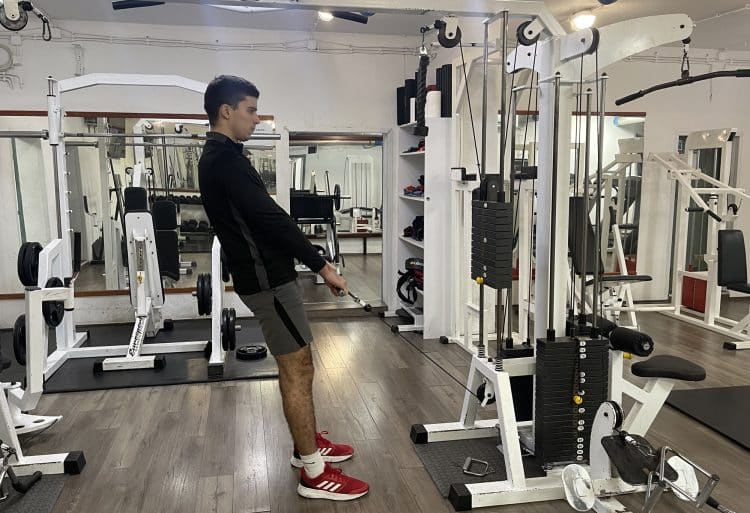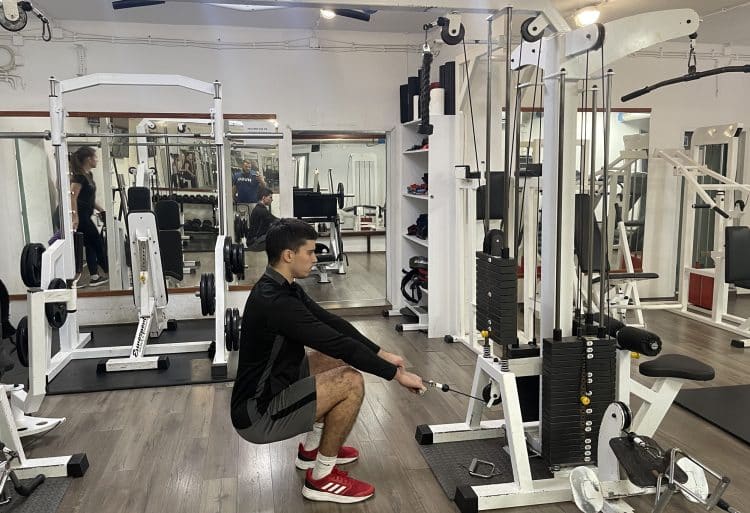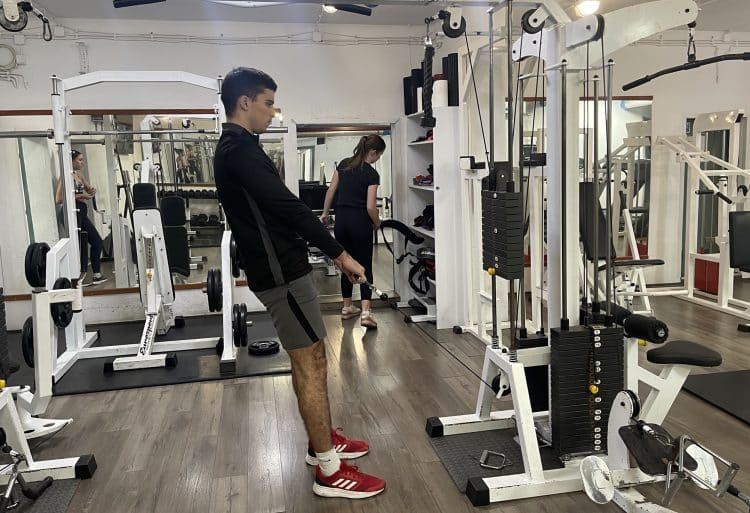Pain and injuries are common among elite athletes and recreational lifters who go heavy on compound lifts like squats, bench presses, and deadlifts.
One of the studies titled “Narrative review of injuries in powerlifting with special reference to their association to the squat, bench press, and deadlift” stated that sub-elite to elite lifters report that 22% to 32% of their injuries stem from squatting. (1)
That’s why I always diversify squat workouts with my clients. Accessory exercises like cable squats can come in handy to plug any gaps in your training. However, learning the proper form and implementation of cable squats is crucial for lowering the chance of lower back injury.
Incorporating cable squats instead of back squats can drastically lower the chance of injuries without sacrificing performance.
After 20 hours of research and years of performing cable squats, I crafted this exercise guide to help you master this lift.
How To Perform Cable Squats: Step-By-Step Guide
Below is a simple cable squat guide:
Level Up Your Fitness: Join our 💪 strong community in Fitness Volt Newsletter. Get daily inspiration, expert-backed workouts, nutrition tips, the latest in strength sports, and the support you need to reach your goals. Subscribe for free!
Step One — Assume the Starting Position

Pin an appropriate weight on the cable machine. Secure a straight handlebar attachment to the pulley and set it to the lowest position. Grab the bar with both hands in front of your hips and step back. Assume a shoulder-width stance and turn your toes outward slightly. Keep your knees extended and back straight.
Pro Tip: Ensure that the weight set on the cable machine is challenging but manageable. Grip the bar firmly with both hands to maintain control throughout the movement.
Step Two — Descend Into a Squat
Bend your ankles, knees, and hips to lower into a squat. When you achieve the desirable squat depth, hold the position for one second.
Pro Tip: Lower toward the ground slowly. Ensure stability during the eccentric phase for better muscle activation and a lower chance of injury.
Step Three — Return to the Starting Position
Extend your ankles, knees, and hips simultaneously to return to the starting position. Proceed with the next repetition.
Pro Tip: Explode through the concentric phase without compromising your form.
Muscles Targeted by Cable Squats
Here are the primary muscles worked during the cable squat:
- Quadriceps
- Gluteus maximus
- Hamstrings
Also, here are the secondary muscles worked:
- Calves (gastrocnemius and soleus)
- Core musculature (including the rectus abdominis and obliques)
- Lower back (erector spinae)
- Adductors (inner thigh muscles)
Benefits of Cable Squats
Cable squats have worked wonders for many of my clients. Here are the most important benefits of this exercise:
- Greater range of motion
- Versatile resistance adjustment
- Lower risk of injury, especially your lower back
Now, let’s tackle all of these below.
Greater Range of Motion
Cable squats allow you to achieve a better range of motion (squat depth), resulting in greater muscle fiber recruitment and muscle and strength gains. A greater range of motion will also help you build functional strength. This is especially useful for athletes.
Versatile Resistance Adjustment
Another reason I like cable machines is that they offer more weight adjustments than free weights. Small weight increments are great for progressive overload for beginners.
Progressive overload involves increasing your sets, reps, or external resistance. There is more to progressive overload, but this is the simplest definition. (2)
Lower Risk of Injury
Since the load isn’t placed directly on your spine, cable squats are among the safer squat variations. Also, you can let go of the bar attachment if it feels too heavy without worrying about injuring yourself.
Generally, cable squats don’t stress your lower back as much as other squat variations.
Best Cable Squat Variations and Alternatives
The best cable squat variations and alternatives are sumo cable squats, goblet squats, landmine squats, dumbbell squats, and bodyweight squats. I often implement these with my clients, especially when trying to avoid back squats.
Level Up Your Fitness: Join our 💪 strong community in Fitness Volt Newsletter. Get daily inspiration, expert-backed workouts, nutrition tips, the latest in strength sports, and the support you need to reach your goals. Subscribe for free!
Sumo Cable Squat
Sumo cable squats are excellent at targeting your inner thighs.
Steps:
- Pin an appropriate weight on the cable machine and set the bar attachment at the lowest position.
- Grab the t-bar with both hands and step back.
- Assume a wider-than-shoulder-width stance.
- Turn your toes slightly outward. Keep your knees extended and back straight.
- Bend your ankles, knees, and hips.
- When you achieve the desirable squat depth, hold that position for one second.
- Reverse the motion to return to the starting position.
Pro Tip: Ensure your knees are aligned with your toes throughout the movement to avoid strain.
https://www.youtube.com/watch?v=gm5jGsirAyk&pp=ygURU3VtbyBDYWJsZSBTcXVhdHM%3D
Goblet Squat
Goblet squats are a beginner-friendly squat variation.
Steps:
- Pick a kettlebell and hold it in the goblet position.
- Assume a shoulder-width stance with your feet.
- Turn your toes slightly outward.
- Ensure your back is straight throughout the entire movement.
- Lower into a deep squat and hold for one second.
- Reverse the motion to return to the starting standing position.
- Repeat for the desired reps.
Pro Tip: Hold the weight close to your chest to maintain a vertical torso. This maximizes the core and quad engagement.
Landmine Squat
Landmine squats are an excellent variation to help you build leg strength while working on your core stabilization. In fact, in my experience, they are ideal for improving both shoulder and core strength and stability.
Steps:
- Secure a barbell by inserting one of its ends into a landmine attachment.
- Load the free end of the bar with an appropriate weight.
- Assume a shoulder-width stance.
- Turn your toes slightly outward.
- Bend your ankles, knees, and hips simultaneously.
- When your thighs break parallel with the floor, hold for one second.
- Extend your ankles, knees, and hips to return to the starting position.
Pro Tip: Maintain a firm grip on the bar and keep your chest up throughout the exercise.
Dumbbell Squat
Dumbbell squats are one of the easier squat variations. They are beginner-friendly and help you drill squat mechanics before progressing to more complex squat variations.
I prefer implementing dumbbell squats with my beginner clients who still need to master proper form and develop base-level strength.
Steps:
- Pick dumbbells of appropriate weight and hold them at your sides.
- Assume a shoulder-width stance and point your toes slightly outward.
- Keep your back straight throughout the entire exercise.
- Bend your ankles, hips, and knees simultaneously. When your thighs break parallel, hold that position for one second.
- Reverse the motion to return to the starting position.
- Repeat for the desired repetitions.
Pro Tip: Keep the dumbbells at your side with your arms straight. Ensure they move in a vertical line throughout the exercise. This helps maintain balance and proper alignment.
Bodyweight Squat
Bodyweight squats are a regression exercise. You should perform them if cable squats feel too hard. Additionally, you can easily incorporate bodyweight squats into your initial warm-up before more challenging squat variations.
Steps:
- Assume a shoulder-width stance and point your toes slightly outward.
- Keep your back straight throughout the exercise to avoid injuries and excessive stress on your lower back.
- Bend your ankles, hips, and knees simultaneously.
- When your thighs break parallel, hold that position for one second.
- Reverse the motion to return to the starting position.
- Repeat for desired repetitions.
Pro Tip: Engage your core throughout the movement to maintain a straight back.
FAQs
How do cable squats compare to traditional barbell squats in terms of effectiveness?
Cable squats are safer than back squats, which is one of their biggest benefits. However, traditional squats are much more effective if you want to increase your strength, power output, or hypertrophy. Barbell back squats are better at targeting your lower body muscles while allowing you to lift much heavier.
Can cable squats effectively target and improve core strength and stability?
Absolutely. Cable squats are excellent at channeling your core strength and stability. This is because you must hold the bar in a fixed position. This action alone forces all your core musculature to get activated so you can prevent the barbell from moving anywhere.
What are the common mistakes to avoid during cable squats?
The most common cable squat mistakes I witnessed with my clients include incorrect weight selection, improper foot placement, and rounding the back.
How should I program cable squats in my workouts?
You should program cable squats in your workouts as an accessory exercise if you are an experienced lifter. However, if you are a beginner, you can perform cable squats as the main exercise in your leg day. You can also use cable squats for warm-ups before performing more challenging squat variations.
Wrapping Up
Cable squats are an excellent beginner-friendly squat variation that can help with strength gains and hypertrophy. They will allow you to achieve better squat depth while lowering injury risk.
I prescribe my beginner clients cable squats to let them master the movement mechanics before proceeding with more complex squat variations. In the comments below, let me know your thoughts on cable squats and how you incorporate them into your lower-body workouts.
References:
- Bengtsson V, Berglund L, Aasa U. Narrative review of injuries in powerlifting with special reference to their association to the squat, bench press, and deadlift. BMJ Open Sport Exerc Med. 2018;4(1):e000382. Published 2018 Jul 17. doi:10.1136/bmjsem-2018-000382
- Peterson MD, Pistilli E, Haff GG, Hoffman EP, Gordon PM. Progression of volume load and muscular adaptation during resistance exercise. Eur J Appl Physiol. 2011;111(6):1063-1071. doi:10.1007/s00421-010-1735-9
Relevant Articles:
- The 12 Best Cable Exercises for Legs + Workout
- 11 Cable Chest Exercises to Develop Serious Pec Power
Interested in measuring your progress? Check out our strength standards for Bench Press, Bodyweight Squat, Goblet Squat, and more.










